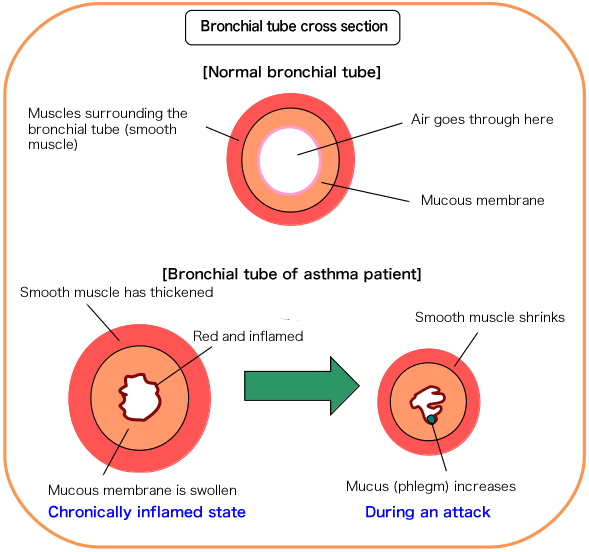Adult asthma
Last updated on: 8 April 2019 | Released on: 21 April 2017
What is adult asthma?
Asthma is an allergic disease of the respiratory tract. House dust, pet dander, cigarette smoke, vigorous exercise, or viral infections can cause your bronchi to contract and your mucous membranes to swell, producing more mucous and phlegm resulting in narrowed airways. Asthma causes wheezing and/or coughing and breathing difficulties when serious. One characteristic of this condition is the repeated bouts of asthmatic attacks. These attacks may subside spontaneously or with the help of bronchial dilators, but may sometimes require emergency treatment or hospitalization, and in rare cases may be life-threatening.
Another thing to keep in mind is that the airway (trachea/bronchi) inflammation is always there, even when you have no attack symptoms. You are constantly at risk of an asthmatic attack, which may strike at any time. Treating this chronic airway inflammation will allow you to live your life free of asthma attacks.
Some people with adult asthma first developed the condition as a child and either continued to have the condition or had a relapse. Other adult asthmatics develop the condition for the first time in middle age.
In any case, it is believed that asthma can be controlled by proper treatment. Genetic predisposition is also a major factor. Once asthma occurs, it becomes a chronic condition which cannot be completely “cured.”

Factors which may cause or trigger an asthma attack
As for the asthma patient, his/her respiratory mucosa become so sensitive that it reacts with various stimuli. The main causes are shown in the followings. You can prevent asthmatic attacks by knowing what cause may raise an asthma attack.
- Smoke from cigarettes or fireworks
- Inhaled allergens (dust mite droppings and carcasses, house dust, mold, animal fur and dander, insect parts, pollen, etc.)
- Viral or other respiratory tract infections
- Climate or weather conditions (seasonal changes or severe weather conditions such as typhoons)
- Strenuous exercise (exercise-induced asthma)
- Stress
- Medication (an asthma attack may occur after receiving a painkiller or fever reducer containing aspirin etc., either orally or by injection. This is referred to as aspirin-induced asthma. Individuals who react to this type of medical ingredient must be careful not only of oral medication and shots but also of suppositories, plasters, and patches which contain the ingredients, as these may trigger attacks as well.)
Diagnosis
Diagnosis of asthma is performed by a doctor who asks you questions, examines you (such as by listening to your breathing), and performs tests as needed. Tests are sometimes required to determine whether you have asthma or another illness with similar symptoms. The results are evaluated comprehensively, and seasonal changes are factored in, to make a diagnosis of asthma.
Next: TreatmentTreatment
The goals of treatment are:
- Relieving airway inflammation and preventing symptoms;
- Relieving airway constriction and alleviating symptoms;
- Allowing the patient to lead lives in the same way as healthy people;
- Preventing worsening of breathing function now and in the future; and
- Preventing asthma from taking the patient’s life.
It is unwise to rely solely on bronchodilators, as these medications only alleviate the symptoms of asthma and do not treat the underlying condition. To ensure that treatment goals are achieved, it is important to use inhaled steroids every day, even when you don’t have any symptoms.
Basics of treatment
- Medication: Regular medication and inhalation with the doctor’s guidance
- Environmental management: Patient and family work together to reduce irritants and triggers from the living environment
- Self-care: Patient takes an active part in his/her treatment, acquiring the knowledge and judgment required to continue proper management
Medication (Regular medication and inhalation with the doctor’s guidance)
Asthma medicines come in two types: Medicines for long-term control, and quick-relief medicines to treat asthma attacks.
Long-term asthma control medications
These include steroid medications which are inhaled even when you have no symptoms, to soothe inflammation of the airway and prevent attacks.
Even when your child has no symptoms, his or her airway is inflamed. It is important to relieve airway inflammation by daily, regular use of long-term asthma control medications (such as inhaled steroids).
Quick-relief medications
You use quick-relief medicines to help relieve asthma symptoms when they happen. They come in forms such as inhalers and tablets. Inhalers act more quickly, because they deliver the medicine directly to your airway.
However, these quick-relief medicines only relieve symptoms temporarily. To ensure proper, day to day control of your condition, it is important to use a long-term asthma control medication every day on a regular basis, to keep airway inflammation down over the long term. This will help prevent attacks.

